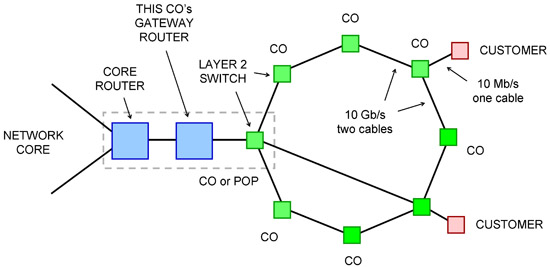We are constantly updating our courses as technologies emerge and mature. Following is an update implemented in our training over ten years ago (this tutorial originally appeared in our newsletter at the time the update was made). Note that we explain fiber, Ethernet and VLANs before we get to this page in the workbook!
Optical Ethernet means communicating MAC frames point-to-point between network devices by flashing a laser on and off to represent the 1s and 0s that make up the frame.
Optical Ethernet MANs let carriers deliver standard 10 Mb/s, 100 Mb/s and 1 Gb/sec Ethernet interfaces at the customer premise - appearing to the user exactly as any other Ethernet jack on the patch panel.
This jack at the customer premise is connected via fiber optics to a port on a Layer 2 Ethernet switch owned by the carrier. The range from the switch to the customer is 3 - 6 miles with cheap 1310-nm single mode fiber technology, and over 40 miles with single-mode fiber and 1550-nm technology. Most new builds now use single-mode fiber.
The carrier has many of these Layer 2 Ethernet switches in a dense urban market like Chicago. These switches are connected in rings and semi-meshed architectures in the metropolitan area at 10 Gb/s (802.3ae), 40 Gb/s or 100 Gb/s.
This forms the Metropolitan Area Network (MAN) backbone, 10 Gb/s or more on fiber around town with points of presence at these Layer 2 Ethernet switches in COs and remotes, offering spokes at speeds from 10 Mb/s to 1 Gb/s and more to anyone nearby.
Several of these switches will also be connected to 10 Gb/s or 100 Gb/s connections on MPLS routers at the CO. This router will in turn connect to that CO's gateway router, which is connected to the core. The core provides high-availability, high-capacity communications to other COs, other cities, other carriers and other networks.

The diagram shows a MAN connecting COs around town. The same architecture is applied within a neighborhood, i.e. a MAN originating at one CO connecting to VDSL remotes near that CO for residences or fiber customers who want redundant access.
The basic function of the MAN is to transfer an Ethernet frame from the jack at the customer premise to a jack or line card on another piece of equipment somewhere else. For a business customer, this could be:
- Another location of the same customer, either Layer 2 Virtual Private LAN Service (VPLS) or Layer 3 Virtual Private Network (VPN) service;
- A carrier providing "SIP trunking", that is, handling all the VoIP phone calls to and from that customer location
- An Internet Service Provider (ISP), that is, a company handling all of the Internet traffic to and from that location.
Of course, a carrier like AT&T would be interested in providing all of these services to a business customer over the same MAN.
For privacy, VLANs are used to make the two end devices the only members of a shared broadcast domain. This also improves the efficiency on the shared 10 Gb/s trunks.
To avoid requiring a piece of equipment to provide three LAN jacks at the customer premise, the Layer 2 switch where the customer is connected could be set up with multiple MAC addresses for each hardware port and software implementation of trunked VLANs.This must be configured on the switch. Alternatively, a single VLAN can be established, and IP addresses and routing used to direct the traffic to the appropriate destination.
Traffic prioritization can be implemented within the MAN by prioritizing on the 802.1p frame field by the switches. Traffic prioritization can be implemented end-to-end by prioritizing MPLS labels on IP packets.
Related Courses
These topics are covered in online certification courses:- TCO CTNS Certified Telecommunications Network Specialist – Course 2211 LANs, VLANs, Wireless and Optical Ethernet
- TCO CTNS Certified Telecommunications Network Specialist – Course 2214 MPLS and Carrier Networks
- TCO CTA Certified Telecommunications Analyst – Course 2407 Introduction to Datacom and Networking
- TCO CTA Certified Telecommunications Analyst – Course 2408 Data Coding, Frames and Packets
- TCO CTA Certified Telecommunications Analyst – Course 2411 LANs, VLANs, Wireless and Optical Ethernet
- TCO CTNS Certified Telecommunications Network Specialist – Course 2414 MPLS and Carrier Networks









